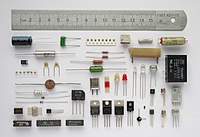
Photo from wikipedia
The optoelectronic properties of halide perovskite materials have fostered their utilization in many applications. Unravelling their working mechanisms remains challenging because of their mixed ionic–electronic conductive nature. By registering, with… Click to show full abstract
The optoelectronic properties of halide perovskite materials have fostered their utilization in many applications. Unravelling their working mechanisms remains challenging because of their mixed ionic–electronic conductive nature. By registering, with high reproducibility, the long-time current transients of a set of single-crystal methylammonium lead tribromide samples, the ion migration process was proved. Sample biasing experiments (ionic drift), with characteristic times exhibiting voltage dependence as ∝ V–3/2, is interpreted with an ionic migration model obeying a ballistic-like voltage-dependent mobility (BVM) regime of space-charge-limited current. Ionic kinetics effectively modify the long-time electronic current, while the steady-state electronic currents’ behavior is nearly ohmic. Using the ionic dynamic doping model (IDD) for the recovering current at zero bias (ion diffusion), the ionic mobility is estimated to be ∼10–6 cm2 V–1 s–1. Our findings suggest that ionic currents are negligible in comparison to the electronic currents; however, they influence them via changes in the charge density profile.
Journal Title: ACS Energy Letters
Year Published: 2022
Link to full text (if available)
Share on Social Media: Sign Up to like & get
recommendations!